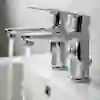Share:
If you’ve been searching for a way to keep your bathroom taps looking as good as new, then you may have come across ‘tap buffing.’ A term used to refer to the process of cleaning and polishing taps, this quick and easy process can regularly help you restore your taps shine while maintaining their condition.
An important part of home maintenance that offers several benefits, both aesthetic and functional, here The Bathroom Showroom explores some of the key factors of buffing your bathroom bath and basin taps.

Why Buff Bathroom Taps?
- Restores Shine and Improves Appearance: Over time, taps can lose their luster due to water spots, soap scum, and mineral deposits (limescale). Buffing removes these blemishes, bringing back the tap's original, "like-new" shine and making it a more attractive feature in your bathroom.
- Prevents Buildup and Corrosion: Hard water contains minerals like calcium and magnesium that leave behind deposits. Soap scum and general grime also accumulate. Regular buffing and cleaning prevent this buildup, which can otherwise lead to corrosion and damage to the tap's finish and internal components.
- Extends Tap Lifespan: By removing corrosive buildup and preventing damage, tap buffing helps preserve the integrity of the materials. This prolongs the life of the tap, saving you the cost of premature replacement.

- Maintains Performance: Mineral deposits can clog the tap's aerator, reducing water flow and pressure. Regular cleaning and buffing help keep these components clear, ensuring the tap operates efficiently and effectively.
- Promotes Hygiene: Taps can be a breeding ground for bacteria and mold, especially in bathrooms. Cleaning and buffing inhibit the growth of these germs by removing the grime and residue they thrive on.
- Enhances the Overall Look of the Room: A clean, sparkling tap contributes to a sense of overall cleanliness and can significantly enhance the visual appeal of bathroom. It's a small detail that can make a big difference in a room's aesthetic.
Important Note: The specific method for buffing a tap depends on its material (e.g. chrome, stainless steel, brass, bronze). It's crucial to use the right cleaning products and techniques to avoid scratching or damaging the finish. Harsh chemicals and abrasive scrubbers should be avoided. In many cases, a simple solution of vinegar and water, followed by a gentle buff with a soft cloth, is all that's needed to achieve a great shine.
FAQs About Tap Buffing
Buffing your bathroom taps is a great way to keep them looking new and extend their lifespan. Here are some frequently asked questions and answers to help you get started.
What Is Tap Buffing, and Why Should I Do It?
Tap buffing is the process of cleaning and polishing bathroom taps to remove dirt, grime, water spots, and mineral deposits, thereby restoring their shine. It's a key part of maintaining your taps because it not only makes them look better but also prevents the buildup of corrosive substances that can damage the finish and shorten the tap's life.
What’s the Difference Between Cleaning and Buffing?
- Cleaning is the regular, often daily or weekly, removal of surface dirt, soap scum, and grime using a mild soap and a soft cloth.
- Buffing is a deeper process that involves a polish or special cleaning agent to remove more stubborn buildup and restore a brilliant shine. It's typically done less frequently, perhaps monthly or as needed.

What Tools and Products Do I Need for Buffing Bathroom Taps?
The products you use are highly dependent on the type of material your tap is made of. Always check the manufacturer's care instructions first, but generally you will need:
- Soft, non-abrasive cloths: Microfiber cloths are excellent for cleaning and buffing as they won't scratch the surface.
- Mild soap and water: A simple solution for everyday cleaning.
- White vinegar and water solution: A 50/50 mixture is highly effective for dissolving limescale and mineral deposits. You can soak a cloth in the solution and wrap it around the tap for 15-30 minutes for stubborn buildup.
- Specific metal polish: For a deeper shine, you can use a polish designed for the tap's material (e.g. chrome, brass, stainless steel). Be sure to choose a non-abrasive formula.
- A soft toothbrush: This is great for getting into hard-to-reach crevices and around the base of the tap.
- Protective waxes: Some people use a protective wax or sealant (like a car wax) to create a barrier that repels water and prevents future buildup.
How Do I Buff Different Types of Bathroom Tap Finishes?
It's crucial to use the correct method for your tap's finish to avoid permanent damage.
- Chrome: This is a very common finish. Use a soft cloth with mild soap and water. For water spots and limescale, a vinegar and water solution works well. For buffing, a non-abrasive chrome cleaner or a car wax can be applied to restore the shine. Never use abrasive tools or cleaners like steel wool or scouring pads, as they will scratch the chrome.
- Brushed or Satin Finishes: These finishes are not as shiny as chrome. They can be easily scratched, so it's even more important to use soft cloths and mild cleaners. Avoid buffing too aggressively, as this can wear away the brushed effect.
- Gold-Plated: These taps are more delicate. Stick to a gentle cleaning solution of mild soap and water. A vinegar and water solution can be used for limescale, but use it with caution and rinse thoroughly. Avoid abrasive cleaners and buffing compounds that could damage the thin gold layer.
- Matte Black: Matte black finishes are very susceptible to scratches and can show water spots and grime more easily. Use only a mild soap and water solution with a soft cloth. Avoid using vinegar, harsh chemicals, or any type of abrasive cleaner that could cause fading or damage the finish.
How Often Should I Buff My Bathroom Taps?
- Regular Cleaning: A quick wipe-down with a soft cloth and mild soap after each use is the best way to prevent buildup.
- Buffing: Depending on your water hardness and how much the tap is used, a more thorough buffing with a polish is recommended every month or two to maintain the shine and prevent long-term damage.
Can I Use Household Items to Buff My Taps?
Yes, many household items can be effective.
- A vinegar and water solution is excellent for removing hard water spots.
- A paste made from baking soda and water can be used on a soft cloth to gently scrub away grime.
- Some people also use a small amount of toothpaste (not the gel kind) to gently polish small scratches, but this should be done with caution and only on durable finishes like chrome. Always test on a small, inconspicuous area first.
For further bathroom ideas and bathroom inspiration, why not browse our Rest and Relaxation blog section? Or, book an appointment with The Bathroom Showroom. Experts in all things bathrooms, we can help turn your dream bathroom into a reality.
